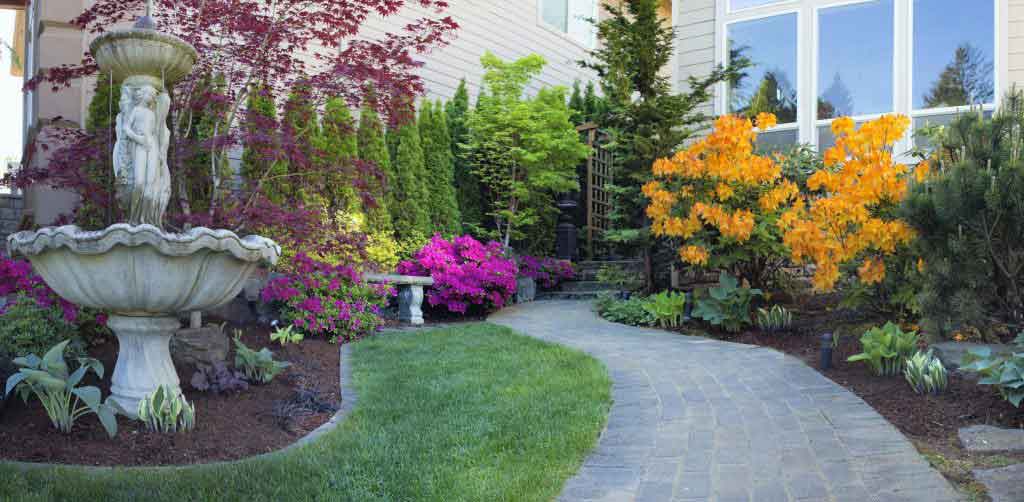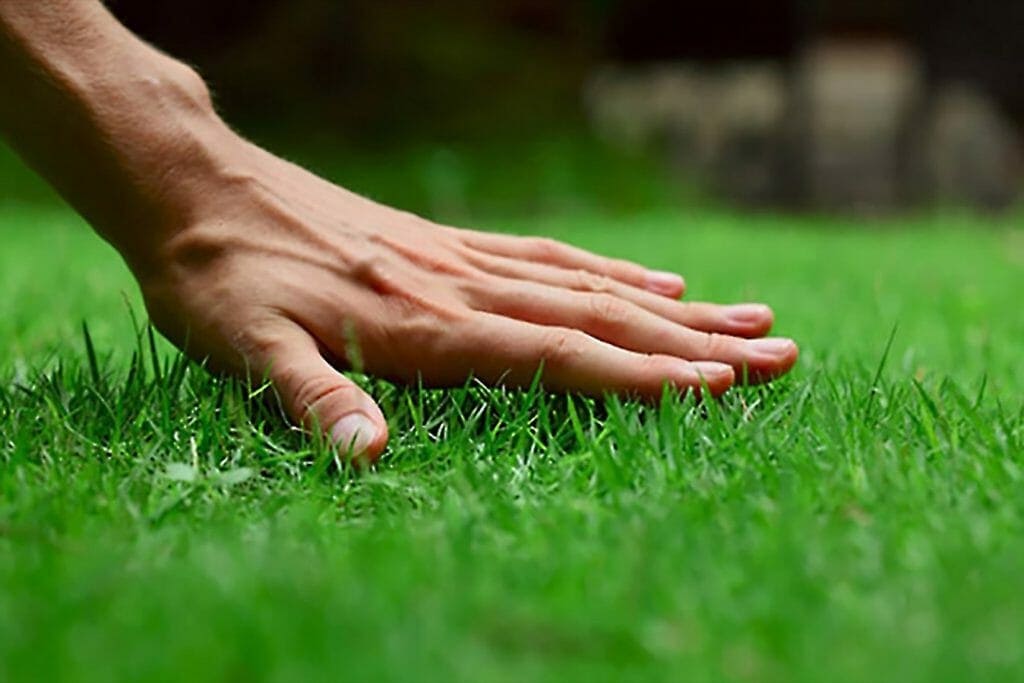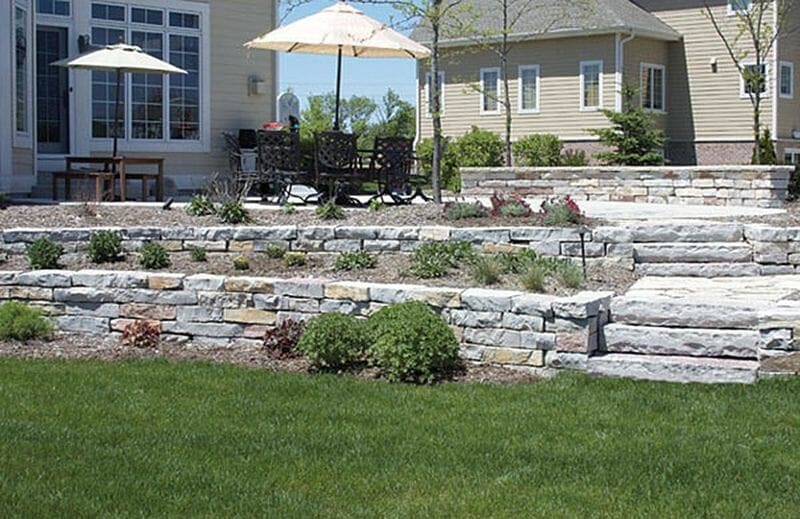Written by FRAN J. DONEGAN and published on https://www.hunker.com/
Landscaping improves your home’s value and curb appeal. Landscaping takes on many forms, from installing trees, shrubs, and a lawn to creating a patio with a gazebo and walkways.
In most situations, landscaping includes designing and planning your land usage, getting the land ready, and planting or installing your desired additions. Unless you are an experienced landscape designer, it’s usually something best left to experienced professionals. Let’s take a look at all the landscaping prices, including material and installation costs below.
How Much Does Landscaping Cost?

Whether starting from scratch or reviving an existing yard, landscaping can account for a large chunk of the family budget. One rule of thumb is to invest 5 to 10 percent of your home’s worth on landscaping. Landscaping can add up to 15 percent to the value of your home.
Landscaping costs can range from a few dollars to buy and plant a few small flowers or shrubs to tens of thousands of dollars to build a patio, add walkways and boulders, or plant large trees. You can save money by doing much of the work yourself, although some landscaping projects require heavy equipment and large quantities of mulch or topsoil.
The term “landscaping” means a number of things. It is the front yard plantings that are designed to enhance the curb appeal of the home. It is also the backyard amenities that aid in relaxation and entertaining. And it is the unsexy stuff that is usually hidden but is there to solve a problem such as poor drainage.
There are as many landscaping projects as there are interior remodeling projects. Here’s a list of some of the common ones.
Hiring a Landscape Designer
About $50 to $150 per hour; more for some landscape architects.
Not everyone needs the advice of a professional landscape designer, but if you are planning a large project and one that involves a number of different components, it is worthwhile considering hiring a pro. They not only know what types of plants are best for your yard, they can also spot potential problems, such as poor drainage areas or soil that needs amendments to help the plants thrive. And because they are designers, they should come up with design ideas that you never thought of.
Many designers are affiliated with garden centers. If the garden center supplies the plants and handles the installation, the design is usually figured into the overall budget for the project.
Installing French Drains
$20 to $30 per linear foot installed.
French drains are trenches that contain perforated PVC pipe and gravel whose purpose is to direct water from one area to another. They are sometimes installed at the base of foundation walls to direct water away from the structure. In the landscape, they can move rainwater away from poor-draining areas to a spot in the landscape that can absorb the water and allow it to drain away. To be effective, the trench needs to slope about 1 inch for every 8 feet of run.
To do the job yourself, you will need the PVC drain pipe and gravel. Expect to pay about $100 to $500 for the materials. The biggest part of the job is digging the trench, although you can rent equipment to help with this, which will cost $100 to $200 per day.
Topsoil, Mulch or Gravel
Many projects, such as creating planting beds, walkways and other structures, require large quantities of soil, mulch or gravel. Here are some average landscaping costs:
- Topsoil: $7 to $12 per cubic yard
- Fill soil: $7 to $12 per cubic yard
- Mulch: $15 to $65 per cubic yard
- Gravel: $20 to $120 per cubic yard
There may be a delivery charge when ordering bulk material, although some garden centers and stone yards will offer free delivery to local customers who order large quantities.
For small projects, home centers and garden centers sell small bags of topsoil and mulch. Just be aware that you will pay a premium for bagged material. A cubic foot of top-quality bagged topsoil could cost as much as $100 in some regions.
Installing a Sod Lawn
$1 to $2 per square foot installed; materials: 35 cents to 85 cents per square foot.
Contractor costs for a sod lawn will go up if there is extensive prep work for such things as removing tree roots, dealing with rocky soil or regrading.
The sod installation process usually includes removing the old grass, rototilling the soil, fertilizing and adding compost. The sod sections can dry out quickly, so it is best that they are installed the same day they are delivered or the next day if necessary. Seams where the ends of sod strips meet should be offset in adjacent rows. Once the sod is down, the contractor will go over the lawn with a lawn roller to help level the area and bond the sod to the underlying soil. Sodded lawns need to be watered daily for two weeks. Check with the sod supplier for exact watering instructions.
Berms and Mounds
Berms are slightly raised areas in the landscape that add visual interest. They can serve as boundary markers between sections of lawn or to provide privacy. The most common type is a berm planted with some combination of annuals, perennials, shrubs and even small trees.
To look natural, berms should have a slightly irregular shape, rather than one with hard angles. Berms should only rise about 18 to 24 inches from ground level. The width of the berm should extend out about 5 feet for every foot of rise. The length should be about four to six times the width.
Because berms can affect the drainage of the surrounding area, it is best to get the advice of a landscape professional. The pro can also help with estimating the materials to construct the berm. They usually consist of a fill material such as rubble of some sort, followed by a clay-heavy soil, then 4 to 5 inches of good topsoil.
Plants are usually about one-third to one-half of a landscape budget, and creating berms is no exception. Here are some average plant costs:
- Perennials: $2 to $3 each
- Shrubs: $4 to $25 each
- Small trees: $60 to $140 each
Installing Flagstone Walkways
$15 to $20 per square foot installed; materials: $5 to $10 per square foot.
Walkways serve a number of landscaping purposes: They add visual interest to a yard, connect areas with one another and keep foot traffic off the lawn.
Walkways should be at least 3 feet wide. The shape of the walkway will depend on the yard, but those that curve provide more visual interest than those that run in a straight line.
The term flagstone is actually a catchall phrase for a several types of natural stone, such as slate, bluestone and sandstone, that are cut into thin slabs.
Other possible walkway materials include:
- Poured concrete: about $2 per square foot for materials
- Pavers: about $4 to $8 per square foot for materials
Landscape Edging Materials
Material costs range from $1 per linear foot for plastic edging and $2 to $3 per square foot for standard, preformed concrete blocks. Extruded concrete poured on site is $4 to $5 per square foot. Cost of timber edging is about $6 to $10 per square foot.
Edging, or curbing, gives a landscape a finished look. The products can define the edges of a walkway or the perimeter of a patio. Use edging to separate the bottom of a berm from the surrounding lawn.
Installing edging is a common DIY project, but it does require a little digging. Some products, such a plastic edging, are locked in place by driving long spikes through predrilled holes. Others, such as stone pavers, are usually set on an inch or so of sand. Others can mortared in place over a concrete slab.
Installing a Patio
$10 to $20 per square foot for installation; $5 to $35 per square foot for materials.
Patios extend outdoor living space and are often the centerpiece of a backyard entertainment area. Pavers are usually installed over a gravel and sand base. Be aware that some municipalities limit the amount of nonporous surfaces such as patios and walkways because they contribute to runoff after a rainstorm.
Putting in Retaining Walls
Retaining walls are one solution to a sloped landscape site, allowing you to create flat stepped areas that are easier to garden or tend grass. Prices for retaining walls vary, depending on the material used. Average costs for materials only include:
- Cinder/concrete block: $10 to $15 per square foot
- Poured concrete: $20 to $25 per square foot
- Wood timbers: $15 to $25 per square foot
- Stone/boulders: $8 to $12 per square foot
- Brick: $14 to $15 per square foot
In addition to materials costs, expect to pay anywhere from $53 to $58 an hour for installation, depending on the skill level required. Concrete cinder block can cost $60 to $75 per hour for labor, while an elaborate dry-stone or mortared stone wall can cost $60 to $80 per hour. Nationally, the average retaining wall costs about $5,500 dollars, with typical ranges between $1,200 and $14,000.
Installing a Sprinkler System
About 21 cents to $1 per square foot of yard, or $500 to $1,000 per zone.
Contractors often price installation by zone. A typical installation might have a front lawn zone, a side yard zone and another for the backyard. Each zone is watered separately so that the water pressure remains constant.
Installing an Outdoor Lighting System
About $2,000 to install a low-end lighting system, to $6,000 for a high-end system; $190 to $450 for low-voltage lighting cost.
The term outdoor lighting includes a number of different types of fixtures that serve a number of purposes, such as lighting a walkway for safety, highlighting individual trees and shrubs for effect, and lighting for security purposes.
Low-voltage kits are available for DIY projects that range from $190 to $450. The quality of the fixtures accounts for the difference in price.
Original post here https://www.hunker.com/13710305/how-much-does-landscaping-cost/.



